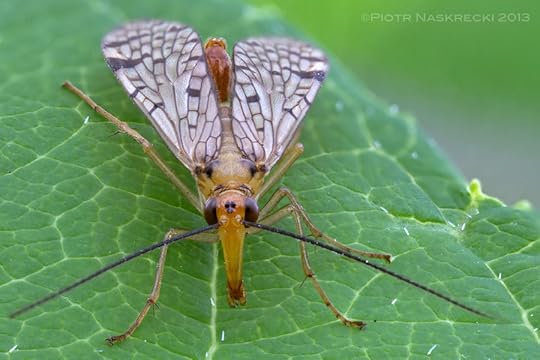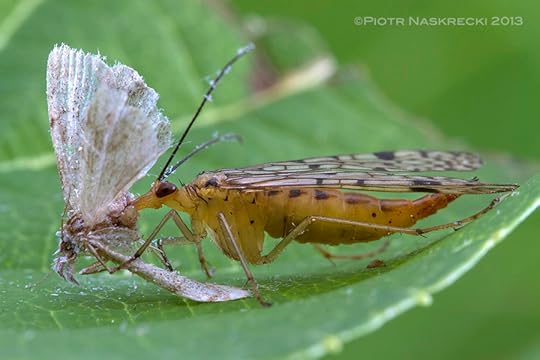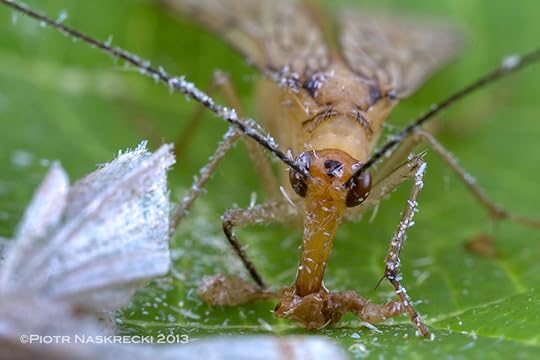Scorpionflies

A male scorpionfly (Panorpa acuta) from Estabrook Woods, MA.
The Estabrook Woods near the town of Concord, MA have over the years become my favorite local place to find interesting insects and ancient plants. It is also a great location to let my dogs exercise their primeval desire to chase little furry things (always unsuccessfully) and wade in stagnant, swampy water. Recently I wrote about my failed search there for scorpionflies (although one that resulted in finding something equally interesting), but this past weekend I had much better luck, and was able to see and photograph these elusive insects in action.
Why the obsession with scorpionflies? To begin, scorpionflies (or rather their immediate ancestors) carry the distinction of being some of the oldest insects with the complete metamorphosis (Holometabola). Permian panorpoids, dating back at least 290 million years, but already shockingly similar to modern species, eventually gave rise to not only scorpionflies (Mecoptera), but also the now dominant flies (Diptera) and butterflies (Lepidoptera), plus a few smaller orders. Cretaceous fossils of scorpionflies are so similar to current species that I doubt I would be able to spot anything unusual if one flew right in front of me.

A female scorpionfly feeding on a dead moth. Unlike their close relatives, hanging scorpionflies (Bittacus), members of the genus Panorpa usually feed on insect carrion rather than trying to catch live ones.
But scorpionflies, especially those of the genus Panorpa that I have been searching for, are also incredible in their reproductive behavior. Many insects have elaborate courtship, with males (usually) displaying awesome ornaments, crazy behaviors, or feats of strength, all to impress a female. One fairly common way of wooing her is to present the female with a nuptial gift, often in the form of a prey item, or a packet of carbohydrates and protein attached to the spermatophore (the spermatophylax). Male scorpionflies, however, somehow manage to make themselves desirable to females by offering them a big glob of their own spit. For this reason they have evolved exceptionally large salivary glands, much bigger than those of the females. (This is, by the way, an excellent example of the randomness of sexually selected characters.) In most species of Panorpa a male may also get lucky if he offers the female a tasty dead insect or try to force her to mate by brutal force, but nothing beats a nice, juicy ball of spit. So enticing is this nuptial gift that males of some species of Panorpa feel confident enough to produce sexual pheromones, something that usually only females of insects do, and nothing gets a female scorpionfly more excited than a whiff of the aldehyde (2E,6Z)-nona-2,6-dienal For Men.
[image error]
A male and a female of Panorpa acuta – the male’s scorpion-like “tail” carries his genitalia and a so-called notal organ, which helps him hold the female’s wings during copulation.
A recent study (Engqvist, L. 2011. Behavioral Ecology 22: 345-349) showed an intriguing relationship between the attractiveness of the male and his investment in mating (as measured by the duration of the copulation and the quality of the nuptial gift, which in turn are directly related to the quality of the offspring). The study showed, perhaps counterintuitively to some, that the more attractive the male the less invested in the mating he is, including presenting the female with a nuptial gift of subpar quality. On the other hand, nerdy males offer both a better mating experience and a bigger nuptial gift to the females. Think about it.

A female scorpionfly breaking off a piece of the moth’s body and chewing it with her sharp mandibles.
Filed under: Behavior, Mecoptera


Piotr Naskrecki's Blog
- Piotr Naskrecki's profile
- 9 followers



